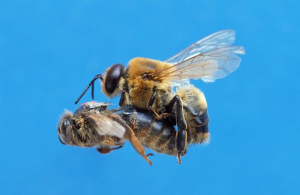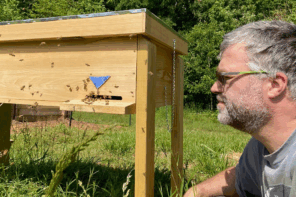 Queen/Drone Mating
Queen/Drone Mating
By: Clarence Collison
There are many environmental conditions that are required for mating flight activity. Temperature and weather are the most important factors in northern regions. Drones and young queens remain inside their colonies, waiting for the stimuli offered by agreeable temperatures and weather conditions. The minimal temperature for drone flight is around 18°C (64°F), while for queens it is about 20°C (68°F). Strong winds, cloudy skies and rain prevent mating flight activity. Warm days with blue or partly cloudy skies offer the optimal environment for honey bee mating activity (Koeniger et al., 2014).
Drones exit the hive to mate as their only goal, despite the high chances of getting lost, being preyed upon and starving; and only if they are lucky, they will die when mating. These nuptial flights take place in Drone Congregation Areas, and their hive exit time is normally in the afternoons. During the Spring and Summer mating seasons, drones emerge from the hive, perform orientation flights and search for drone congregation areas for mating. This search may lead drones to return to their colony, drift to other colonies (vectoring diseases and parasites) or simply get lost to predation. Drone activity at other hours of the day have not been studied. Using three methods (direct observation, video recording and radio frequency identification (RFID)), drone activity was evaluated during the whole day in Northwest Argentina. Twenty-four-hour activity was detected for the first time. Surprisingly, several drones were active at dawn, morning and late morning. They also discovered that drones may stay in the hive for several days, even after initiation of search flights (up to four days). They also observed drones to leave the hive for several days to return later (up to three days). All three methods confirmed that drones were mostly active in the afternoon. The activity at dawn and during the morning could be a normal pattern in drones around the world, or it could be a result of abnormal factors, such as environmental variables altering their biological clocks (Ayup et al., 2021).
Drone attraction to ether extracts of virgin queens (Apis mellifera L.) demonstrated that chemical communication enables the drones to orient themselves to queens during mating flights. The primary source of queen mating attractants is the mandibular glands. Fractionation of mandibular gland lipids yielded several attractive fractions that may act jointly. One fraction was queen substance (9-oxodec-2-enoic acid) (Gary, 1962).
Since mating occurs in the air away from the hive, studying mating behavior and the actual process has been difficult. An apparatus was described by which tethered virgin queens could be suspended for restricted flight at desired heights up to 11 meters, enabling observations on mating. Drones were attracted in large numbers and seemed to show normal mating behavior. Their flight near the queen was described in detail, and the methods by which they locate her. Drones, first attracted by the scent of queen sex attractants, approached from windward, flying typically in sparse swarms that assembled and hovered in conical formation below and behind the tethered queens. Drones were consistently observed to mount on top of the queen’s abdomen, but successful mating followed rather rarely. Mating behavior was very stereotyped; the drone clasped the queen’s abdomen and everted the genitals into the sting chamber, which must be open. Paralysis of the drone accompanied the onset of genital eversion; this caused the drone to swing over backwards, attached by the genitals which everted more completely as the physical restraints inherent in the initial position were released. Finally, as the drone hung from the queen, the mating act was terminated by an audible snap, presumably caused by compressed air in the drone genitals, and apparently serving to separate the drone physically from the queen. Mating required only a few seconds, and in normal circumstances the entire act probably takes place in the air (Gary, 1963).
Many free-flying drones were induced to ‘mate’ with queens in which an open sting chamber was simulated by the removal of abdominal segments seven through 10, leaving an open body cavity. Lack of success in getting routine matings, using either the tethering technique or the release of free-flying queens, was probably due to failure on the part of the virgin queens to open their sting chambers (Gary, 1963).
Drone behavior must be considered carefully when conducting bioassays of sex attractants. Weakly attractive fractions are difficult to detect unless drones are attracted into the neighborhood by a lure of crude queen lipid extract, or a tethered virgin queen (Gary, 1963). Wooden models of queen bees, when treated with queen pheromones and elevated (five to 15 meters), stimulated mating behavior of flying drones. When sting chamber depths, of 1.6, 4.8 mm or ‘infinite’ were tested at diameters of 1.6, 2.4, 3.2 and 4.0 mm, respectively, the ‘mating’ frequency for the respective diameters (all depths pooled) was 4.6, 20.0, 46.7 and 44.8 percent (N=240), respectively, for 762 drones that mounted the models. Sting chamber dimensions affected the degree of drone genital eversion. The median time between mounting and eversion was 2.4 seconds. Prolonged mount duration (median=17.8 seconds) was observed when models had sting chambers too small to stimulate eversion. The data document the brevity of mating and the open sting chamber requirement (Gary and Marston, 1971).
In a two-choice test, drones preferred queen models marked by a distinctly colored ‘mating sign’ (secretions of the drone’s copulatory organs) to unmarked models. This was true also for models marked by aluminum foil. Dark-colored drones preferred to copulate with light-colored models and vice versa. Models carrying copulating drones were more attractive than single models. Thus, a copulating drone as well as the mating sign and other colored markers increased the attractiveness of a queen. The mating sign may indicate a form of cooperation between drones by marking a queen after sperm transfer to facilitate the identification of a queen by the following drones (Koeniger, 1990).
Highly polyandrous queens mate with six to 18 drones in one or more nuptial flights when they are about four to six days old, prior to egg laying. During subsequent copulations in the air, semen from each drone is ejaculated forcefully into the vagina and lateral oviducts of the queen. The ejaculates are pressed and probably mixed in greatly expanded lateral oviducts by both subsequent explosive ejaculations of drones and muscular contractions of the reproductive tract of the queen before the migration of spermatozoa into the spermatheca. The queen returns to the hive after mating, with an average of 11.5 μL semen in her lateral oviducts and about 100 million spermatozoa in the entire genital tract (Woyke, 1962).
During mating, pursuing drones are positioned below and behind the fast-flying queen, forming a comet- like mass. They focus on her with their huge eyes, with the upper front part having the highest resolution. The fastest drone closes in on the queen, accelerates as he flies above the queen and his thorax touches her abdomen. His four front legs grip her abdomen from the sides while both hind legs grasp the abdomen from below with their hairy inner part and press it against the drone’s thorax. The queen is held tightly. Docking of the drone and the queen has been completed successfully. Now the drone adjusts his position by curving his abdomen down until it is placed directly in the sting chamber kept open by the queen. During this maneuver the drone flies and keeps pace with the queen’s flight. The time from grasping the queen until separation of the pair takes less than two seconds (Koeniger et al., 2014).
Drones are able to remove the mating sign of predecessors at the beginning of copulation. It is attached to the hairy field on the ventral side at the basis of the endophallus (Koeniger, 1986). The sequence of a queen mating with numerous drones is described as follows: “The first drone has mated and inserted his mating sign into the sting chamber of a queen before falling to the ground. The hairy patch at the base of the endophallus of the first drone is empty. A second drone mounts the queen and begins the mating process, having pulled out the mating sign of the first drone. The first drone’s mating sign is sticking to the hairy patch on the endophallus of the second drone. Now, the second drone inserts his mating sign into the sting chamber of the queen before falling to the ground and the sequence of events continues with each drone” (Koeniger et al., 2014).
Queens returning from successful mating flights have the semen in lateral oviducts and the mating sign in the sting chamber. The mating sign consists of part of the bulb of a drone endophallus. It is located between the elevated sting and the ventral terminal sclerite.
The size of measured signs; height, width and length (without the thin thread at the end), was 1.75 mm, 1.60 mm and 3.21 mm, respectively. The chitinized plates of the mating sign were situated, in most queens, at the ventral side of the sting chamber almost parallel to the terminal sclerite. The pointed ends of the chitinized plates were directed cranially, toward the bursa copulatrix. However, in some queens the chitinized plates of the sign were situated almost vertically to the sclerite (Woyke, 2011). After the last copulation more than 70% mated queens return carrying the last mating sign in her sting chamber. After return from the mating flight, it is removed mostly by the queen rubbing the abdomen on the comb (Koeniger and Koeniger, 2004).
Queens return from successful mating flights with the mating sign, which consists of chitinized plates of drone endophallus filled with mucus. The orange membranes covering both sides of the mating sign do not touch the hairy rim of the bursa copulatrix. The thin thread at the end of the mating sign is pushed forward on the surface of the sign in most queens. This makes the end of the sign look blunt. Simulated stages of natural mating showed that it is impossible for the orange membranes covering the cornua of the endophallus to become stuck to the mating sign of the same drone. Mating signs with additional pairs of orange membranes were found. In some queens, the semen or additional second mating signs were found at the end of the sign protruding from queen’s sting chambers. Those three additional parts originated from drones, which attempted to mate, but failed to remove the mating sign of the predecessor. The thin thread at the end of the mating sign was pushed to the surface of the sign, because the next drone attempted to mate, but failed to remove the sign of its predecessor. The last drone, which failed to mate, left the orange membranes of his endophallic cornua at the mating sign of his predecessor. Thus, the mating sign originates from two drones. The chitinized plates and the mucus originate from one drone, but the orange membranes originate from the last drone(s), which attempted to mate, but failed to remove the sign of his predecessor (Wyoke, 2011).
Five apiaries of nucleus colonies (from west to east: Y, W, O, B, G) were established at 805-meter intervals along a 3220-meter east-west transect in an area of treeless prairie in Kansas, USA. All drones were removed from W, O and G apiaries, and young cordovan drones and brood were added to additional nuclei at Y. Young, marked, wild-type drones were located similarly at B. Virgin queens (>six days) homozygous for the cordovan gene were added to all nucleus colonies when the drones were well established. Eleven days later, these queens were removed and replaced by a second group of virgins. Drones were sampled, sorted and released every five minutes during each flight period. The abundance of cordovan and wild-type drones declined rapidly with increasing distance from their source, and there was general agreement between observed and expected distributions (east to west). It was thus possible to determine the general direction of a queen’s mating flight and the minimal distance she flew by assessing the proportions of wild-type and cordovan bees in her progeny. The results showed that the distribution of queen flight distances differed from the distribution of drone flight distances, with queens flying further than the peak in abundance of drones from their own colony. Where colonies with virgin queens occurred <1600 meters from two or more other colonies, the queens mated predominantly with drones from these sources rather than drones from their own colonies. It is suggested that properly distributed drone sources could be used to dilute genetically (“Europeanize”) a low-density feral population of Africanized bees (Taylor and Rowell, 1988).
Radio-frequency identification (RFID) was used to record the duration and frequency of nuptial flights of honey bee queens (Apis mellifera carnica) at two mainland mating apiaries. They investigated the effect of several factors on flight duration and frequency: mating apiary, number of drone colonies, queen’s age and temperature. Significant differences were found between the two locations concerning the number of flights on the first three days. They also observed an effect of the ambient temperature, with queens flying less often but longer at high temperatures compared to lower temperatures. Increasing the number of drone colonies from 33 to 80 colonies had no effect on the duration or on the frequency of nuptial flights (Heidinger et al., 2014).
References
Ayup, M.M., P. Gärtner, J.L. Agosto-Rivera, P. Marendy, P. de Souza and A. Galindo-Cardona 2021. Analysis of honey bee drone activity during the mating season in northwestern Argentina. Insects 12: 566.
Gary, N.E. 1962. Chemical mating attractants in the queen honey bee. Science 136: 773-774.
Gary, N.E. 1963. Observations of mating behaviour in the honey bee. J. Apic. Res. 2: 3-13.
Gary, N.E. and J. Marston 1971. Mating behaviour of drone honey bees with queen models (Apis mellifera L.) Anim. Behav. 19: 299-304.
Heidinger, I.M.M., M.D. Meixner, S, Berg and R. Büchler 2014. Observation of the mating behavior of honey bee (Apis mellifera L.) queens using radio-frequency identification (RIFD): factors influencing the duration and frequency of nuptial flights. Insects 5; 513-527.
Koeniger, G. 1986. Mating sign and multiple mating in the honey bee. Bee Wld. 67: 141-150.
Koeniger, G. 1990. The role of the mating sign in honey bees, Apis mellifera L.: does it hinder or promote multiple mating? Anim. Behav. 39: 444-449.
Koeniger, N. and G. Koeniger 2004. Mating behavior in honey bees (Genus Apis). Trop. Agric. Res. Ext. 7: 13-28.
Koeniger, G., N. Koeniger, J. Ellis and L. Connor 2014. Mating Biology Of Honey Bees (Apis mellifera). Wicwas Press, Kalamazoo, MI, 155 pp.
Taylor, O.R. Jr. and G.A. Rowell 1988. Drone abundance, queen flight distance and the neutral mating model for the honey bee, Apis mellifera. In: Africanized Honey Bees And Bee Mites, Ellis Horwood, Chichester, UK, pp 173-183.
Woyke, J. 1962. Natural and artificial insemination of queen honey bees. Bee World 43: 21-25.
Woyke, J. 2011. The mating sign of queen bees originates from two drones and the process of multiple mating in honey bees. J. Apic. Res. 50: 272-283.
Clarence Collison is an Emeritus Professor of Entomology and Department Head Emeritus of Entomology and Plant Pathology at Mississippi State University, Mississippi State, MS.









